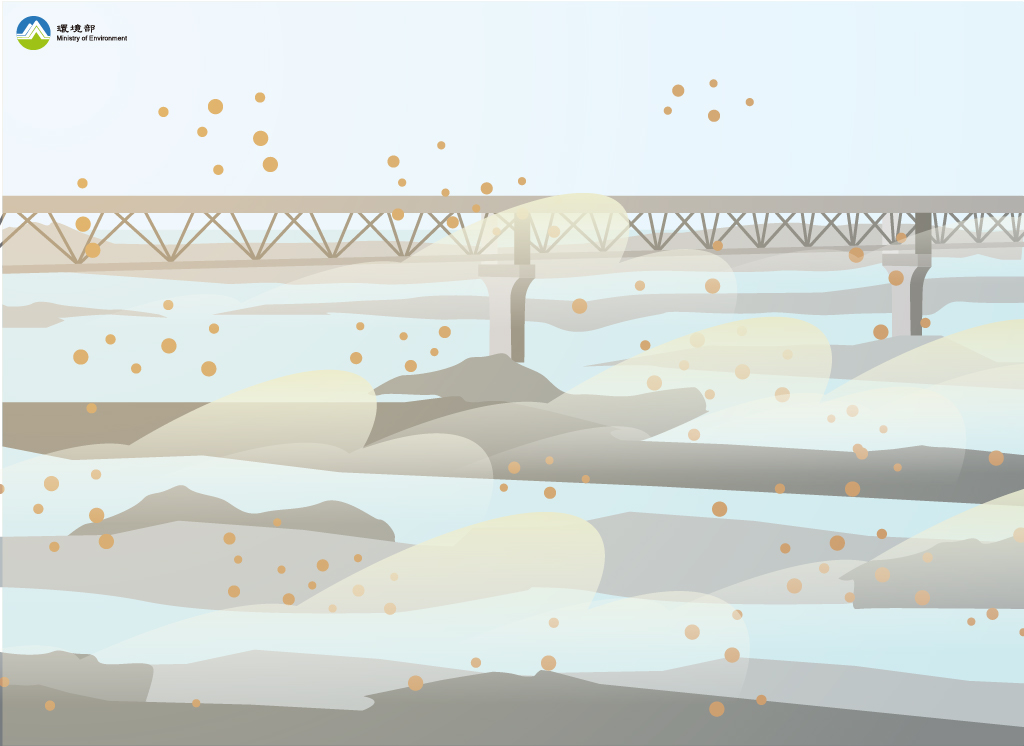Background
Every year, the seasons when the northeast monsoon is the most dominant happen to be dry seasons of rivers in Taiwan. The strong northeast monsoon can easily lift the dust from the exposed riverbed, causing aeolian dust, which directly affects local air quality. The rainy season in Taiwan is generally from May to September. October to April next year is the dry season when aeolian dust is more common.
The air quality monitoring data shows that aeolian dust was detected as early as 1994, and it was more obvious on the leeward side of Zhuoshui River. The most serious incidence of aeolian dust in recent years happened on November 2, 2009. At 1PM in the afternoon, Lunbei Station detected that the concentration of PM10 soared to 2,532 μg/m3, a record high. The aeolian dust of Zhuoshui River could even affect as far as Chiayi County, Chiayi City, Tainan County and Tainan City.
In order to grasp the state of aeolian dust around rivers in a timely manner for air quality forecast, the MOENV installed automatic monitors for particulate matter beside rivers that are prone to aeolian dust, including Daan River, Dajia River, Wu River, Zhuoshui River, Gaoping River, Beinan River and Lanyang River, so to provide data for the people's reference.
The dust heaped on the riverbed becomes aeolian dust when it is lifted by the strong wind, so monitoring sites around the riverbed are more likely to detect high concentration of particulate matter. Furthermore, the aeolian dust might expand along with the strong wind, impacting air quality even more. However, the concentration of particulate matter caused by aeolian dust around the rivers can also drop rapidly, so it only affects air quality in a specific area and for a limited time period. The data collected from monitoring stations around rivers for aeolian dust can only display the influence caused by the aeolian dust on a specific area. It cannot be used to represent regional air quality.
For more information, please visit the web-pages on river aeolian dust monitoring data.

Monitoring Data:
All 77 air quality monitoring stations of MOENV around Taiwan can measure particulate matter (PM10), with Lunbei, Douliu, Mailiao, and Taixi Stations installed in areas where aeolian dust is most common. To strengthen the monitoring of aeolian dust, the MOENV further added outdoor PM10 monitors in source areas of aeolian dust, so to know better how much dust is lifted. In addition, 10 sets of indoor air quality monitors were installed in elementary schools or junior high schools that are most vulnerable to the impact of river aeolian dust as a reference for the schools to adjust students' curriculum for outdoor activities. To further understand root causes of aeolian dust, the MOENV sends mobile air quality monitoring vehicles to areas more prone to the impact of aeolian dust during northeast monsoon season (from October to April next year) to conduct random monitoring, so to help the MOENV understand the impact of river aeolian dust.
The MOENV started to operate an early warning system of river aeolian dust since September 2010. The early warning system adopted monitoring data and forecast data from the Central Weather Administration, in combined with real-time monitoring data of MOENV and simulated results of aeolian dust generated by a local aeolian dust model. The forecasters take all the aforementioned data into consideration, determining the level of influence on western Taiwan and rivers in eastern Taiwan on the day after, and release the result to staff of environmental protection departments in each city and county at 4:30PM every afternoon. The level of influence is divided into four levels, from the least to the most: no influence (≦125 μg/m3), minor influence (126~254 μg/m3), mild influence (255~354 μg/m3) and serious influence (>354 μg/m3). Once related personnel are informed, they can prepare to take responsive measures.